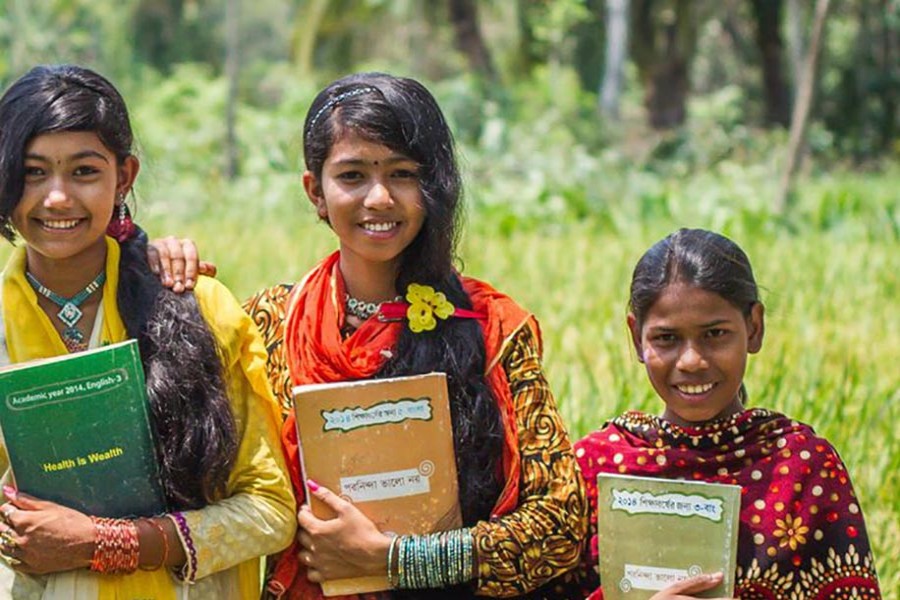That a large portion of the 35 million adolescent population of the country is suffering from malnutrition should have caused policymakers sleepless nights. Girls aged 15-19 are the worst sufferers as one in four is stunted. At the same time incidence of obesity among them is the highest. Deliberations at a roundtable arranged jointly by the World Bank, the United Nations International Children's Emergency Fund (UNICEF), the Global Alliance for International Nutrition (GAIN) and BRAC James P Grant School of Public Health in the city recently have come up with a number of such startling disclosures. Teenage girls of the 11-14 age group are not achieving the physical growth proportionate to their age. A large portion of them are underweight but then quite a significant number of girls belonging to the 15-19 age group is obese.
When adolescent nutrition is in question, here is a clear indication that girls are discriminated against in terms of food intake. The need for micronutrient contents for girls of the age groups concerned is not adequately met. For physical conditions, girls need extra nutrition at the age they just step into puberty. Malnourished boys and girls are less attentive either to their studies or anything of interest. It is the time when the foundation stone of life is laid. So, if girls are more malnourished than boys, they are likely to perform worse and perhaps this partly explains the greater rate of dropouts among girl students of secondary school from certain segment of society.
The country's nutrition status at this level is certainly a cause for concern. But the problem has its origin in earlier stages of life. Although the country has drastically reduced child mortality, it is yet to overcome the challenges of malnutrition, lack of sanitation and hygiene. Of the more than 15 million under-five population, 36 per cent suffer from stunting and 33 per cent from underweight. Thus the country finds itself in a vicious cycle where malnourished adolescent girls become mothers and give birth to underweight babies.
Overall, the country's journey on the road to lower middle-income status is fraught with many pitfalls but none so damaging as this demographic constraint. The country has raised its income level and quality of foods has also improved by leaps and bounds for various segments of people. Yet a large number of people have failed to improve their income and quality of life. Their only hope is their children. But if the young generation belonging to this class does not have enough nutritious foods to grow healthy, they are unlikely to secure their rightful place in society, particularly when competition is getting tougher and education is undergoing radical transformation.
The problem of stunting and wasting is, however, not confined to the underclass alone -children of many well-off families also suffer from malnutrition on account of lack of awareness and care. Also the country's lack of initiative for ensuring food safety, diversification of agriculture into high-value and nutrient-laden products does not help the cause. It is a complete package that has to be developed at the national level. Participation of all stake-holders from their respective positions in the food safety programme can bring about the desired change in the dietary habit and other complementary exercises.
The academic life of the young people has become too dreary and exam-dependent. This has to be changed in order to allow them the liberty of opting for academic disciplines and careers on the strength of their potential and special talent. Students in cities in particular have no time and place for participation in games and sports. Thus they are deprived of proper physical growth. Neglected at this age, their bodies never reach the fitness level they should.
In a country with asymmetric development, certain segments lag far behind the more privileged. Then there are the middle class or lower middle class where children are taken special care of but lack of knowledge of what constitute balanced diet fails to deliver the goods. If the children from the poor families suffer from stunting and wasting, those of the middle class on an average have to sacrifice many of their dietary requirements on account of poor or inadequate knowledge of foods and drinks.
It is because of this, world bodies like the World Health Organisation (WHO) and the Food and Agricultural Organisation and the International Food Information Council have agreed on what is known as the Acceptable Daily Intake (ADI) which is an estimate of the amount of additive one can take with food without health risks. But in this country where there is no limit to use of chemical fertiliser and pesticides, such issues hardly figure in public policy. Even the calorie intake with emphasis on the varieties of foods to ensure balance in nutrition is overlooked. Love for fast foods has exacerbated the situation.
Deworming programme for children is yet to cover the entire nation. The medicine can be administered in the manner vitamin-A capsule is fed to children. Then a food chart indicating the calorie intake for different age groups should be prepared and distributed among the people. A brochure can accompany this to inform of nourishment derived from foods available and at a minimum possible cost. Such matters can be included in syllabi of school students. Even tips on food preparation are essential to avoid overcooking. Health is indeed wealth that must be secured for the young generation in order to develop them as worthy citizens. Here is a nation with an overwhelming proportion of young population. The young generation must be taken well care of so that they can ensure their future well-being.


